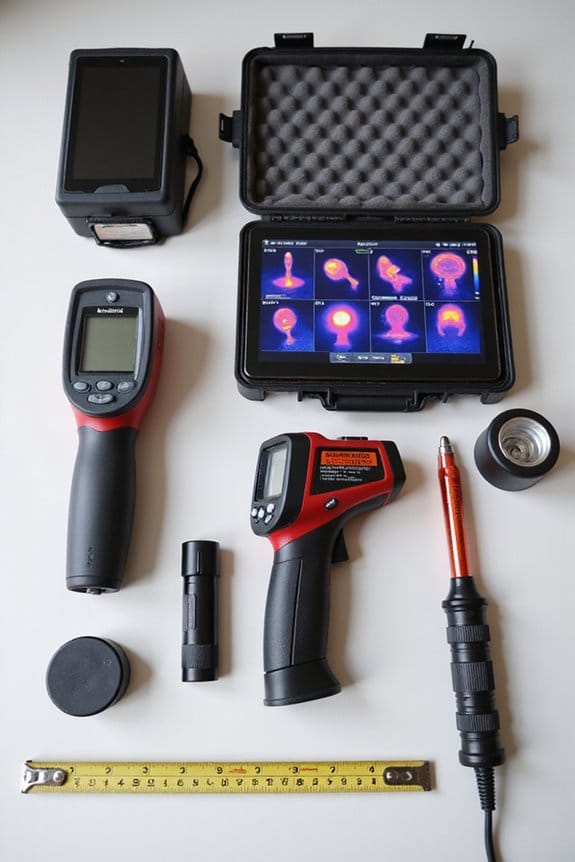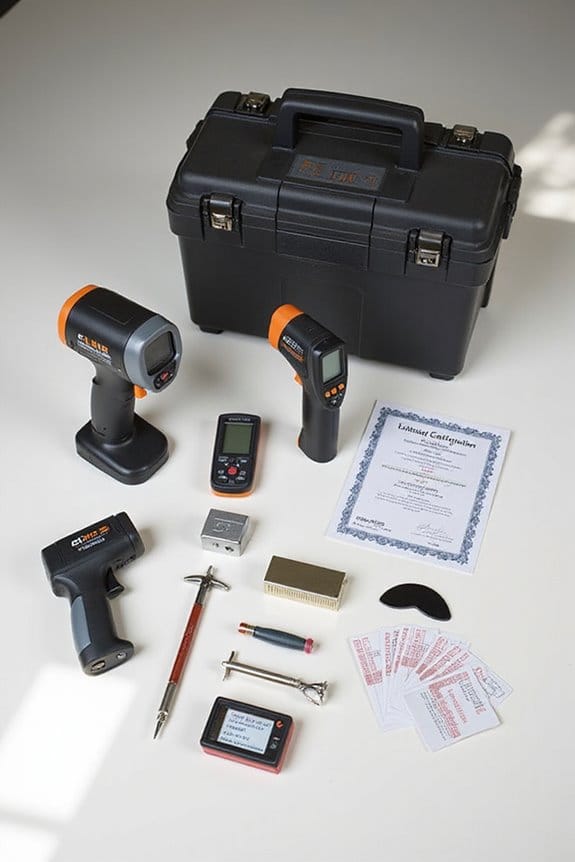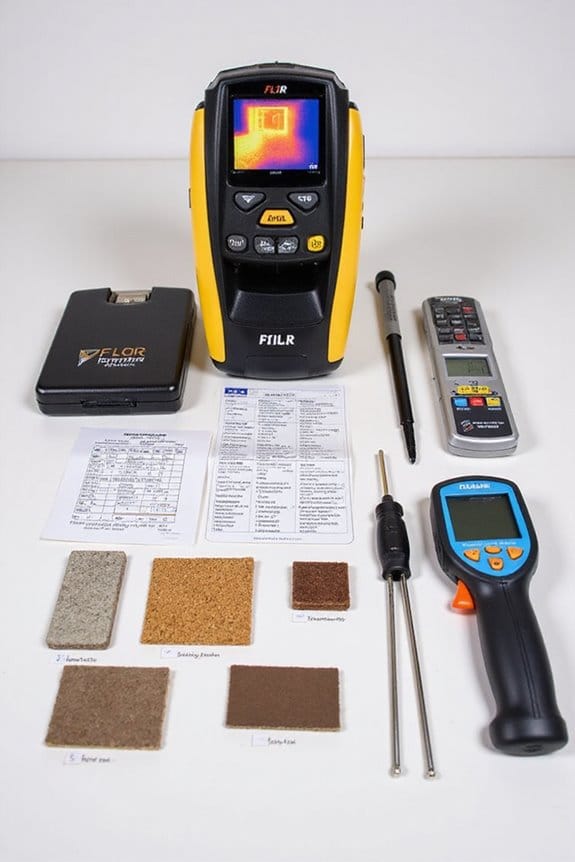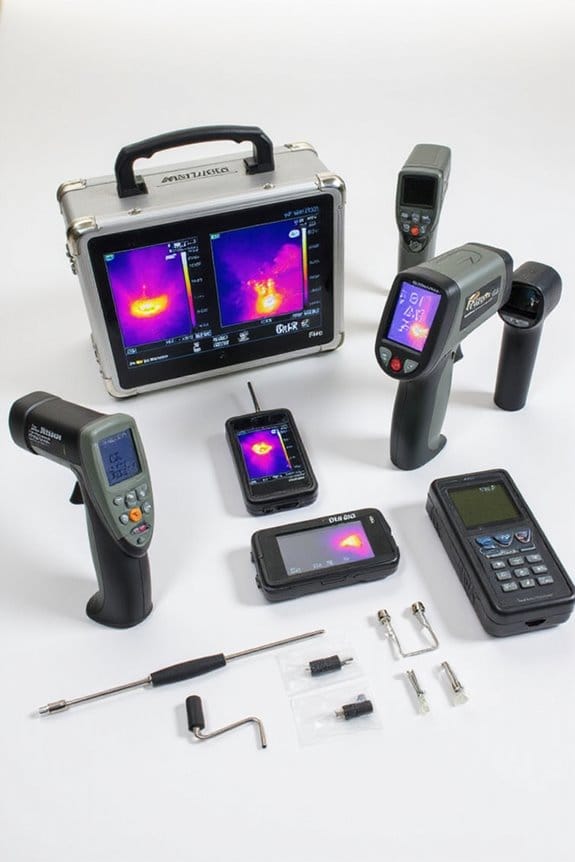Thermal cameras are amazing tools that can detect temperature differences, revealing hidden insights in various fields. Here’s what they can spot: 1) Overheating motors and HVAC issues in industries; 2) Hidden moisture and insulation flaws in buildings; 3) Intruders in total darkness during security checks; 4) Health changes in patients; and 5) Victims in search and rescue operations. They’re like superheroes in a camera! Stick around, and I’ll share even more incredible uses.
Key Takeaways
- Thermal cameras detect temperature variations, identifying hot and cool areas in various environments.
- They can reveal insulation issues and air leaks in buildings, improving energy efficiency.
- In industrial settings, they monitor overheating equipment and ensure safe operational conditions.
- Thermal imaging aids in security by detecting intruders and unusual heat patterns, even in darkness.
- In medical applications, they catch physiological changes early and assess conditions without invasive procedures.
Heat Signature Detection
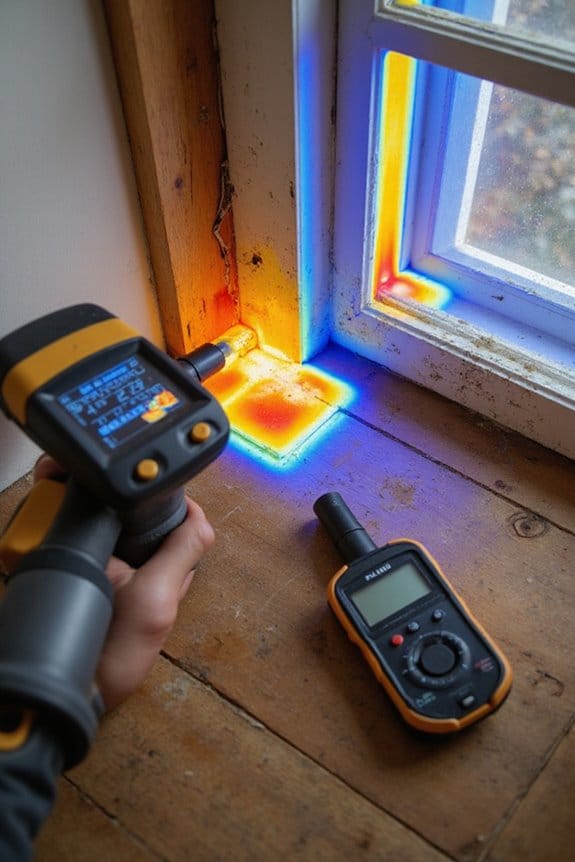
When it comes to detecting heat signatures, thermal cameras really shine, quite literally! They work by picking up infrared radiation emitted by objects based on their temperature. Here’s why I find heat signature analysis and temperature mapping so fascinating:
- Visual Representation: Thermal images use color palettes to show temperature variations. Reds indicate warmth while blues signal cooler areas.
- Detailed Insight: Each pixel on a thermal camera represents a specific temperature measurement, allowing for precise analysis.
- Night Vision: These cameras can detect human presence even in complete darkness or when hidden.
- Proactive Monitoring: You can set temperature thresholds that trigger alerts, helping you catch potential issues early.
- Additionally, thermal cameras are capable of detecting temperature differentials as small as 0.05°F, making them essential for various applications.
In short, thermal cameras let us see the unseen, making them a valuable tool in so many fields!
Industrial Applications
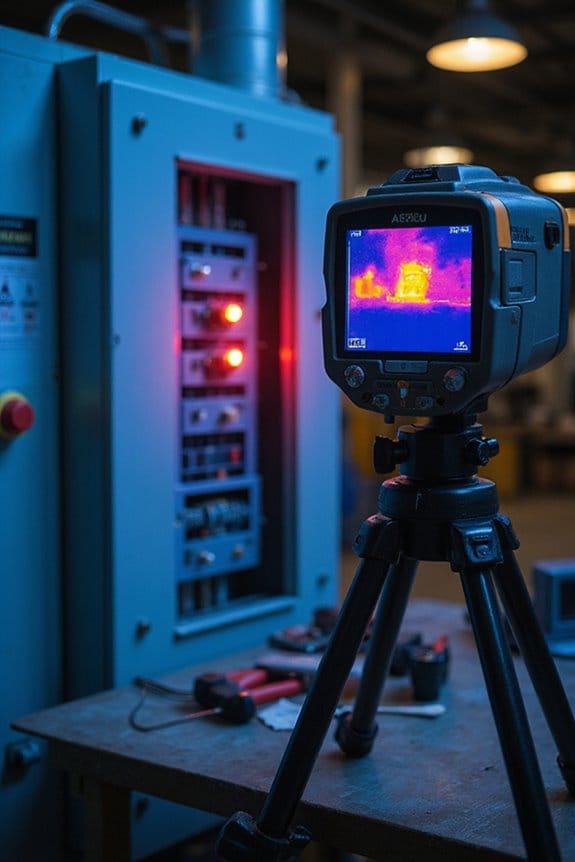
In the world of industrial applications, thermal cameras play an essential role in enhancing safety and efficiency across various sectors. Here’s how they can make a difference:
- Equipment Diagnostics: They help detect overheating motors and failing HVAC systems before they break down, saving you time and money.
- Process Optimization: You can monitor welding for uniform temperature, ensuring high-quality results without the guesswork.
- Leak Detection: In the pipeline industry, thermal imaging identifies gas leaks quickly, reducing risks considerably.
- Food Safety: These cameras check cooking temperatures, helping maintain compliance and quality in food processing.
- Thermal Imaging: Utilizing thermal imaging technology, you can easily identify potential issues that may not be visible to the naked eye.
Using thermal cameras, you not only improve operational efficiency but also create a safer work environment. It’s like having a superhero for your equipment!
Building and Infrastructure Inspection
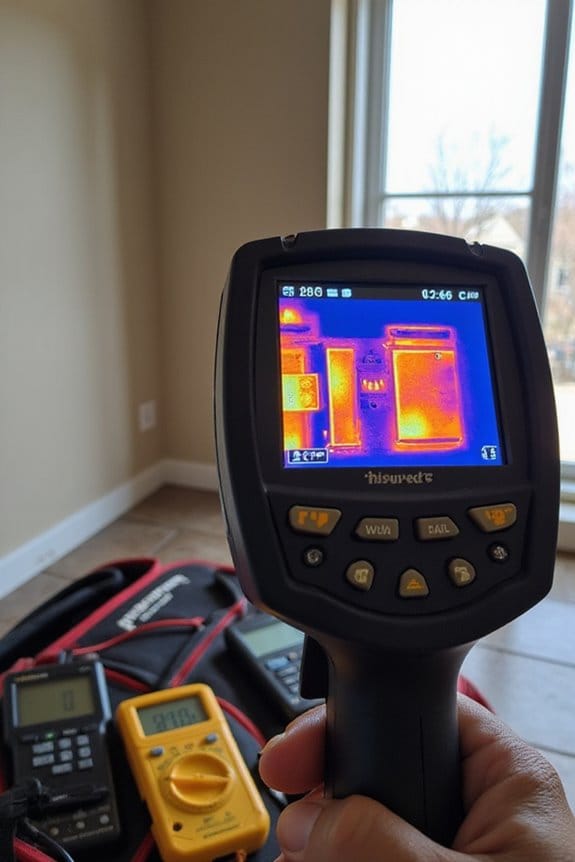
While most of us don’t think about it, building and infrastructure inspection can be a game changer in maintaining energy efficiency and safety. Here’s why I believe thermal cameras are essential tools for this purpose:
- Insulation Checks: They spot insulation issues that lead to energy waste, ensuring compliance with building codes.
- Air Leakage: Thermal imaging finds drafts in hard-to-reach spots, helping you seal leaks and meet inspection regulations.
- Moisture Detection: These cameras reveal hidden moisture, preventing costly repairs and mold growth.
- HVAC Performance: They assess HVAC efficiency, avoiding energy waste and keeping systems balanced. Additionally, the use of thermal imaging cameras can enhance temperature measurement accuracy, ensuring reliable results in inspections.
Using thermal cameras not only boosts comfort but also helps you adhere to safety standards. So, let’s keep those buildings in top shape!
Security and Surveillance

As security threats evolve, it’s become essential to stay one step ahead, especially in today’s unpredictable environment. When it comes to thermal imaging technology, I’ve found it incredibly useful for perimeter security. Here’s why:
- Nighttime Surveillance: Thermal cameras work in total darkness, spotting heat signatures from humans or vehicles.
- Intruder Detection: They can identify intruders even if they’re camouflaged or obscured.
- Real-Time Alerts: Integrated systems can send automatic alerts when unusual heat patterns are detected.
- Weather-Proof: These cameras perform well in fog, rain, or smoke—conditions that often trip up traditional cameras.
Additionally, the temperature ranges of these cameras can adapt to various environments, enhancing their effectiveness in diverse scenarios.
In a world where safety is paramount, investing in thermal technology can give you peace of mind. Who wouldn’t want that?
Search and Rescue and Environmental Monitoring

Thermal cameras aren’t just game changers for security; they also play an essential role in search and rescue operations. Here’s how they help:
- Victim Identification: They detect body heat, making it easier to find survivors in disasters like earthquakes or floods, even in thick smoke or debris.
- Wildlife Monitoring: These cameras can spot wildlife in distress, which might lead rescuers to missing persons or indicate environmental hazards.
- Enhanced Visibility: They work wonders in low-light conditions, allowing teams to operate when traditional methods fail.
- Drone Integration: Drones equipped with thermal cameras can quickly scan hard-to-reach areas, providing real-time data for more effective rescues.
In short, thermal cameras make a huge difference when every second counts! Their high-resolution imaging capabilities ensure precise detection of heat signatures, further enhancing search and rescue efforts.
Medical Applications
When it comes to medical applications, you might be surprised to learn just how versatile thermal cameras can be. Here’s a quick rundown of some thermography benefits:
- Non-invasive and Radiation-free: Perfect for frequent use without the radiation worries.
- Early Detection: It catches physiological changes before they become structural, aiding in timely diagnosis.
- Cost-Effective: These inspections are generally easier on your wallet.
- Diverse Applications: From oncology to cardiology, thermal cameras are making diagnostic advancements.
For instance, they can spot early signs of breast cancer or help monitor inflammation in arthritis. With all these perks, it’s clear that thermal cameras play a vital role in modern medicine, giving us a better chance at staying healthy. Who knew high-tech could be so handy?
Veterinary Applications
While you might think thermal cameras are only for human medicine, they actually have some fantastic applications in veterinary care, too. Here’s how thermal imaging techniques are revolutionizing veterinary diagnostics:
- Lesion Detection: Thermal cameras quickly spot abnormal heat patterns, helping identify injuries and underlying conditions before visible signs show.
- Monitoring Healing: By tracking temperature changes, vets can assess treatment effectiveness and adjust protocols for ideal healing.
- Early Disease Detection: Increased temperatures can reveal issues like osteoarthritis before they become serious, allowing for timely intervention.
- Herd Health: Scanning groups of animals helps quickly spot those at risk, preventing disease spread.
In short, thermal cameras are a game-changer in keeping our furry friends healthy and happy! Who knew technology could be so cool?
Energy Efficiency Optimization
Energy efficiency optimization is as important for our homes and businesses as it is for our furry friends in veterinary care. Here’s how thermal cameras can help us improve efficiency:
- Insulation Upgrades: They detect missing or shifted insulation, revealing heat loss patterns. Regular scans can help track insulation integrity, preventing costly degradation over time.
- Air Leakage Detection: Thermal imaging shows temperature variations around windows and doors, pinpointing air leaks. This can help us seal those gaps and save up to 20% on energy bills!
- HVAC Enhancements: By visualizing heat distribution in our HVAC systems, we can identify blockages and guarantee even heating or cooling.
In a nutshell, thermal cameras are like energy detectives, helping us keep our spaces comfortable and efficient!
Disaster Response and Emergency Services
In the midst of chaos, it’s amazing how thermal cameras can transform disaster response and emergency services. Here’s how they make a massive difference:
- Victim Location: They detect body heat, helping find people in dark or smoky conditions. Talk about a time saver!
- Firefighting Aid: Thermal cameras identify hot spots during and after fires, ensuring no embers are left behind.
- Hazard Identification: These cameras spot hazardous materials at accident scenes, keeping responders safe.
- Structural Assessment: They help assess damage after disasters, guiding teams in maneuvering dangerous debris.
- Night Operations: With thermal imaging, nighttime rescues become less intimidating.
Frequently Asked Questions
Can Thermal Cameras Be Used Outdoors in Extreme Weather Conditions?
Absolutely, I’ve found that thermal cameras excel in outdoor durability and extreme weather performance. They withstand harsh conditions like rain and snow, making them reliable for surveillance and monitoring, no matter the elements.
How Do Thermal Cameras Differ From Regular Cameras?
I know some might think regular cameras are just as good, but their image sensitivity to visible light can’t compete with infrared technology. Thermal cameras detect heat, revealing details invisible to the naked eye, enhancing our perspective.
What Is the Typical Range of Thermal Cameras?
When I think about typical range, long-range detection fascinates me. Thermal sensitivity plays an essential role; some cameras can spot humans up to 30 km away, making them invaluable for various surveillance applications. Isn’t that impressive?
Are Thermal Cameras Safe for Human Exposure?
While I understand concerns about human exposure risks, I find thermal imaging safe. It detects infrared radiation without harmful emissions. As long as I follow guidelines, I feel confident using it without significant safety worries.
Can Thermal Cameras Detect Temperature Variations in Food?
I’ve seen thermal cameras effectively detect temperature variations in food, enhancing food safety and cooking efficiency. They guarantee consistent quality by identifying inconsistencies during cooking and monitoring temperatures throughout the entire food supply chain.

